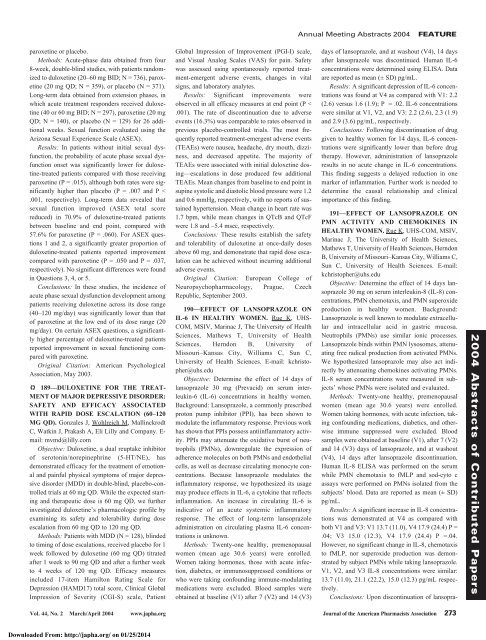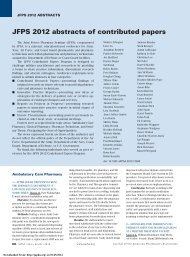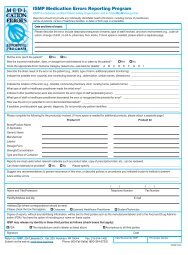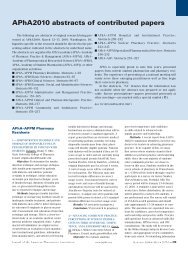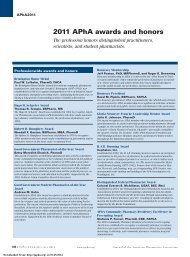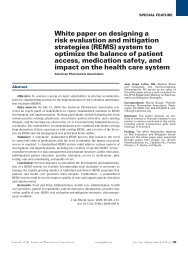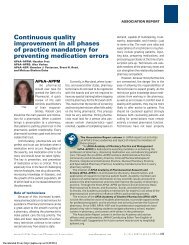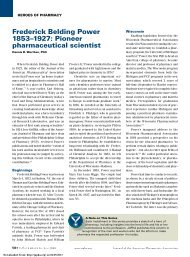Downloaded - Journal of American Pharmacists Association
Downloaded - Journal of American Pharmacists Association
Downloaded - Journal of American Pharmacists Association
You also want an ePaper? Increase the reach of your titles
YUMPU automatically turns print PDFs into web optimized ePapers that Google loves.
Annual Meeting Abstracts 2004<br />
FEATURE<br />
paroxetine or placebo.<br />
Methods: Acute-phase data obtained from four<br />
8-week, double-blind studies, with patients randomized<br />
to duloxetine (20–60 mg BID; N = 736), paroxetine<br />
(20 mg QD; N = 359), or placebo (N = 371).<br />
Long-term data obtained from extension phases, in<br />
which acute treatment responders received duloxetine<br />
(40 or 60 mg BID; N = 297), paroxetine (20 mg<br />
QD; N = 140), or placebo (N = 129) for 26 additional<br />
weeks. Sexual function evaluated using the<br />
Arizona Sexual Experience Scale (ASEX).<br />
Results: In patients without initial sexual dysfunction,<br />
the probability <strong>of</strong> acute phase sexual dysfunction<br />
onset was significantly lower for duloxetine-treated<br />
patients compared with those receiving<br />
paroxetine (P = .015), although both rates were significantly<br />
higher than placebo (P = .007 and P <<br />
.001, respectively). Long-term data revealed that<br />
sexual function improved (ASEX total score<br />
reduced) in 70.9% <strong>of</strong> duloxetine-treated patients<br />
between baseline and end point, compared with<br />
57.6% for paroxetine (P = .060). For ASEX questions<br />
1 and 2, a significantly greater proportion <strong>of</strong><br />
duloxetine-treated patients reported improvement<br />
compared with paroxetine (P = .050 and P = .037,<br />
respectively). No significant differences were found<br />
in Questions 3, 4, or 5.<br />
Conclusions: In these studies, the incidence <strong>of</strong><br />
acute phase sexual dysfunction development among<br />
patients receiving duloxetine across its dose range<br />
(40–120 mg/day) was significantly lower than that<br />
<strong>of</strong> paroxetine at the low end <strong>of</strong> its dose range (20<br />
mg/day). On certain ASEX questions, a significantly<br />
higher percentage <strong>of</strong> duloxetine-treated patients<br />
reported improvement in sexual functioning compared<br />
with paroxetine.<br />
Original Citation: <strong>American</strong> Psychological<br />
<strong>Association</strong>, May 2003.<br />
189—DULOXETINE FOR THE TREAT-<br />
MENT OF MAJOR DEPRESSIVE DISORDER:<br />
SAFETY AND EFFICACY ASSOCIATED<br />
WITH RAPID DOSE ESCALATION (60–120<br />
MG QD). Gonzales J, Wohlreich M, Mallinckrodt<br />
C, Watkin J, Prakash A, Eli Lilly and Company. E-<br />
mail: mvmd@lilly.com<br />
Objective: Duloxetine, a dual reuptake inhibitor<br />
<strong>of</strong> serotonin/norepinephrine (5-HT/NE), has<br />
demonstrated efficacy for the treatment <strong>of</strong> emotional<br />
and painful physical symptoms <strong>of</strong> major depressive<br />
disorder (MDD) in double-blind, placebo-controlled<br />
trials at 60 mg QD. While the expected starting<br />
and therapeutic dose is 60 mg QD, we further<br />
investigated duloxetine’s pharmacologic pr<strong>of</strong>ile by<br />
examining its safety and tolerability during dose<br />
escalation from 60 mg QD to 120 mg QD.<br />
Methods: Patients with MDD (N = 128), blinded<br />
to timing <strong>of</strong> dose escalations, received placebo for 1<br />
week followed by duloxetine (60 mg QD) titrated<br />
after 1 week to 90 mg QD and after a further week<br />
to 4 weeks <strong>of</strong> 120 mg QD. Efficacy measures<br />
included 17-item Hamilton Rating Scale for<br />
Depression (HAMD17) total score, Clinical Global<br />
Impression <strong>of</strong> Severity (CGI-S) scale, Patient<br />
Global Impression <strong>of</strong> Improvement (PGI-I) scale,<br />
and Visual Analog Scales (VAS) for pain. Safety<br />
was assessed using spontaneously reported treatment-emergent<br />
adverse events, changes in vital<br />
signs, and laboratory analytes.<br />
Results: Significant improvements were<br />
observed in all efficacy measures at end point (P <<br />
.001). The rate <strong>of</strong> discontinuation due to adverse<br />
events (16.3%) was comparable to rates observed in<br />
previous placebo-controlled trials. The most frequently<br />
reported treatment-emergent adverse events<br />
(TEAEs) were nausea, headache, dry mouth, dizziness,<br />
and decreased appetite. The majority <strong>of</strong><br />
TEAEs were associated with initial duloxetine dosing—escalations<br />
in dose produced few additional<br />
TEAEs. Mean changes from baseline to end point in<br />
supine systolic and diastolic blood pressure were 1.2<br />
and 0.6 mmHg, respectively, with no reports <strong>of</strong> sustained<br />
hypertension. Mean change in heart rate was<br />
1.7 bpm, while mean changes in QTcB and QTcF<br />
were 1.8 and –5.4 msec, respectively.<br />
Conclusions: These results establish the safety<br />
and tolerability <strong>of</strong> duloxetine at once-daily doses<br />
above 60 mg, and demonstrate that rapid dose escalation<br />
can be achieved without incurring additional<br />
adverse events.<br />
Original Citation: European College <strong>of</strong><br />
Neuropsychopharmacology, Prague, Czech<br />
Republic, September 2003.<br />
190—EFFECT OF LANSOPRAZOLE ON<br />
IL-6 IN HEALTHY WOMEN. Rue K, UHS-<br />
COM, MSIV, Marinac J, The University <strong>of</strong> Health<br />
Sciences, Mathews T, University <strong>of</strong> Health<br />
Sciences, Herndon B, University <strong>of</strong><br />
Missouri–Kansas City, Williams C, Sun C,<br />
University <strong>of</strong> Health Sciences. E-mail: kchristopher@uhs.edu<br />
Objective: Determine the effect <strong>of</strong> 14 days <strong>of</strong><br />
lansoprazole 30 mg (Prevacid) on serum interleukin-6<br />
(IL-6) concentrations in healthy women.<br />
Background: Lansoprazole, a commonly prescribed<br />
proton pump inhibitor (PPI), has been shown to<br />
modulate the inflammatory response. Previous work<br />
has shown that PPIs possess antiinflammatory activity.<br />
PPIs may attenuate the oxidative burst <strong>of</strong> neutrophils<br />
(PMNs), downregulate the expression <strong>of</strong><br />
adherence molecules on both PMNs and endothelial<br />
cells, as well as decrease circulating monocyte concentrations.<br />
Because lansoprazole modulates the<br />
inflammatory response, we hypothesized its usage<br />
may produce effects in IL-6, a cytokine that reflects<br />
inflammation. An increase in circulating IL-6 is<br />
indicative <strong>of</strong> an acute systemic inflammatory<br />
response. The effect <strong>of</strong> long-term lansoprazole<br />
administration on circulating plasma IL-6 concentrations<br />
is unknown.<br />
Methods: Twenty-one healthy, premenopausal<br />
women (mean age 30.6 years) were enrolled.<br />
Women taking hormones, those with acute infection,<br />
diabetes, or immunosuppressed conditions or<br />
who were taking confounding immune-modulating<br />
medications were excluded. Blood samples were<br />
obtained at baseline (V1) after 7 (V2) and 14 (V3)<br />
days <strong>of</strong> lansoprazole, and at washout (V4), 14 days<br />
after lansoprazole was discontinued. Human IL-6<br />
concentrations were determined using ELISA. Data<br />
are reported as mean (± SD) pg/mL.<br />
Results: A significant depression <strong>of</strong> IL-6 concentrations<br />
was found at V4 as compared with V1: 2.2<br />
(2.6) versus 1.6 (1.9); P = .02. IL-6 concentrations<br />
were similar at V1, V2, and V3: 2.2 (2.6), 2.3 (1.9)<br />
and 2.9 (3.6) pg/mL, respectively.<br />
Conclusions: Following discontinuation <strong>of</strong> drug<br />
given to healthy women for 14 days, IL-6 concentrations<br />
were significantly lower than before drug<br />
therapy. However, administration <strong>of</strong> lansoprazole<br />
results in no acute change in IL-6 concentrations.<br />
This finding suggests a delayed reduction in one<br />
marker <strong>of</strong> inflammation. Further work is needed to<br />
determine the causal relationship and clinical<br />
importance <strong>of</strong> this finding.<br />
191—EFFECT OF LANSOPRAZOLE ON<br />
PMN ACTIVITY AND CHEMOKINES IN<br />
HEALTHY WOMEN. Rue K, UHS-COM, MSIV,<br />
Marinac J, The University <strong>of</strong> Health Sciences,<br />
Mathews T, University <strong>of</strong> Health Sciences, Herndon<br />
B, University <strong>of</strong> Missouri–Kansas City, Williams C,<br />
Sun C, University <strong>of</strong> Health Sciences. E-mail:<br />
kchristopher@uhs.edu<br />
Objective: Determine the effect <strong>of</strong> 14 days lansoprazole<br />
30 mg on serum interleukin-8 (IL-8) concentrations,<br />
PMN chemotaxis, and PMN superoxide<br />
production in healthy women. Background:<br />
Lansoprazole is well known to modulate extracellular<br />
and intracellular acid in gastric mucosa.<br />
Neutrophils (PMNs) use similar ionic processes.<br />
Lansoprazole binds within PMN lysosomes, attenuating<br />
free radical production from activated PMNs.<br />
We hypothesized lansoprazole may also act indirectly<br />
by attenuating chemokines activating PMNs.<br />
IL-8 serum concentrations were measured in subjects’<br />
whose PMNs were isolated and evaluated.<br />
Methods: Twenty-one healthy, premenopausal<br />
women (mean age 30.6 years) were enrolled.<br />
Women taking hormones, with acute infection, taking<br />
confounding medications, diabetics, and otherwise<br />
immune suppressed were excluded. Blood<br />
samples were obtained at baseline (V1), after 7 (V2)<br />
and 14 (V3) days <strong>of</strong> lansoprazole, and at washout<br />
(V4), 14 days after lansoprazole discontinuation.<br />
Human IL-8 ELISA was performed on the serum<br />
while PMN chemotaxis to fMLP and sod-cyto c<br />
assays were performed on PMNs isolated from the<br />
subjects’ blood. Data are reported as mean (± SD)<br />
pg/mL.<br />
Results: A significant increase in IL-8 concentrations<br />
was demonstrated at V4 as compared with<br />
both V1 and V3: V1 13.7 (11.0), V4 17.9 (24.4) P =<br />
.04; V3 15.0 (12.3), V4 17.9 (24.4) P =.04.<br />
However, no significant change in IL-8, chemotaxis<br />
to fMLP, nor superoxide production was demonstrated<br />
by subject PMNs while taking lansoprazole.<br />
V1, V2, and V3 IL-8 concentrations were similar:<br />
13.7 (11.0), 21.1 (22.2), 15.0 (12.3) pg/mL respectively.<br />
Conclusions: Upon discontinuation <strong>of</strong> lansopra-<br />
2004 Abstracts <strong>of</strong> Contributed Papers<br />
Vol. 44, No. 2 March/April 2004 www.japha.org <strong>Journal</strong> <strong>of</strong> the <strong>American</strong> <strong>Pharmacists</strong> <strong>Association</strong> 273<br />
<strong>Downloaded</strong> From: http://japha.org/ on 01/25/2014


